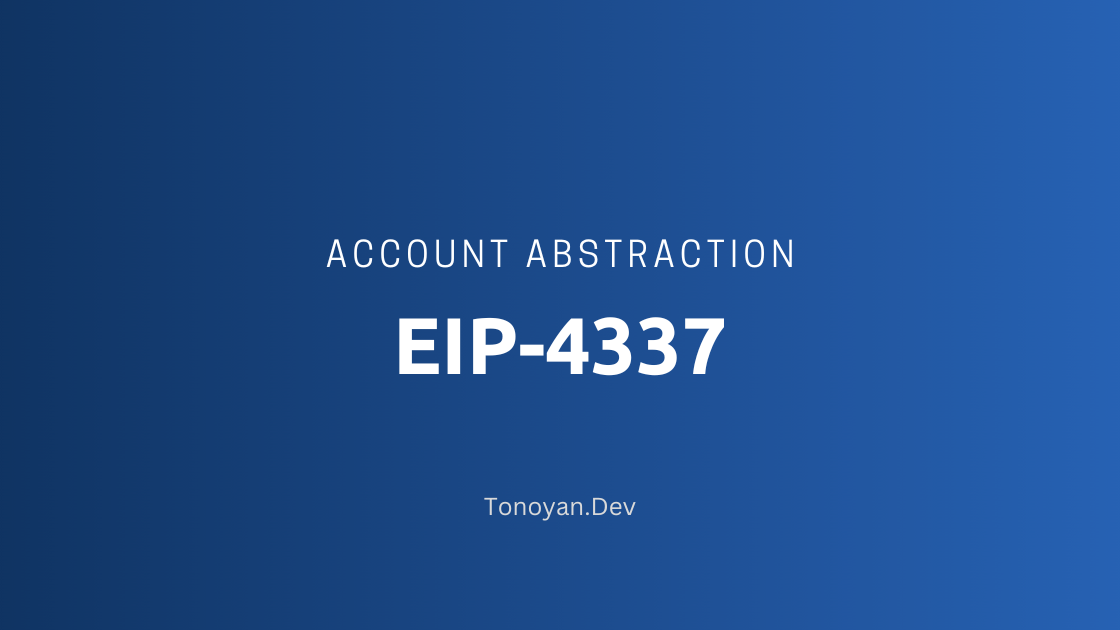EIP-4337 Explained

- Published on

EIP-4337 - Account Abstraction: Your Ticket to EVM Blockchains Amusement Park**
Hello, code magicians of the Blockchain realm! Don your wizard's hat and grab your wand (keyboard), because we're about to delve into the bewitching intricacies of EIP-4337, Ethereum's new Account Abstraction proposal. Spoiler alert: it's going to be a wild ride!

Once Upon A Time In The EVM World...
In the beginning, there was Ethereum 1.0, where accounts were either External Owned Accounts (EOAs) or contracts. They had their predefined roles and rules, with EOAs initiating transactions and contracts responding. It was a bit like high school cliques: Jocks (EOAs) always started the conversations, while nerds (contract accounts) could only reply.
But then came EIP-4337, and suddenly everyone was invited to the party.
Say Hello To EIP-4337
EIP-4337, or Account Abstraction as it's more commonly known, flips the narrative on its head. It introduces a new transaction type, allowing contract accounts to pay gas fees and initiate transactions. This is more than just a small evolution; it's like our nerds have suddenly discovered they're superheroes!

Why Account Abstraction?
EIP-4337 allows for more sophisticated interactions with contracts, broader use-cases, and improved security models. It opens up the playing field for developers, giving us more flexibility and freedom.
But enough of the preamble. Let's jump right into the nitty-gritty, because we're developers and we love a deep dive into the code!
Code Snippet – Contract Initiated Transaction
Before EIP-4337, contracts could only respond to transactions initiated by EOAs. Now, it's possible for contracts to start the conversation:
// Deploy contract
let contract = await ethers.getContractFactory("InitiatorContract");
let initiatorContract = await contract.deploy();
await initiatorContract.deployed();
// Prepare transaction
let transaction = await initiatorContract.populateTransaction.start();
// Broadcast transaction
await initiatorContract.send(transaction);
This revolutionary concept allows contracts to have a life of their own, offering a whole new level of automation and interaction possibilities.

EIP-4337 Mechanics – The Lowdown
The account abstraction mechanism in EIP-4337 introduces a new type of transaction called an "AA transaction" (Account Abstracted transaction).
A typical AA transaction would look something like this:
{
"chainId": 1,
"value": "0x0",
"data": "0x",
"accessList": [],
"type": 2
}
In this case, the type field is what tells the Ethereum network that this is an AA transaction. It's like the secret handshake that gets your transaction into the cool kids club.
Handling PayGas
Handling gas in AA transactions is a bit different. It’s like paying for a round of drinks for your friends at a bar. But here, you need to make sure you've got enough ETH (or in our analogy, cash) before ordering. It's handled by the payGas function in the contract:
function payGas(uint256 gasValue) external {
// Pay for gas
gasPayer.transfer(gasValue);
}
Say Goodbye To Replays
An important aspect of EIP-4337 is its replay protection mechanism. Each AA transaction includes a nonce to prevent replay attacks. It's like your transactions are now wearing unique party hats, making them easily identifiable in a crowd.
In Conclusion...
EIP-4337, with its account abstraction feature, makes Ethereum more dynamic, interactive, and secure. It's like getting a VIP pass to the EVM Blockchains amusement park.
As we boldly go where no Ethereum developer has gone before, we're sure to encounter exciting opportunities, challenges, and of course, more code to conquer. With EIP-4337, the Ethereum world has truly become our playground.
Happy coding!